Page 277 of 474
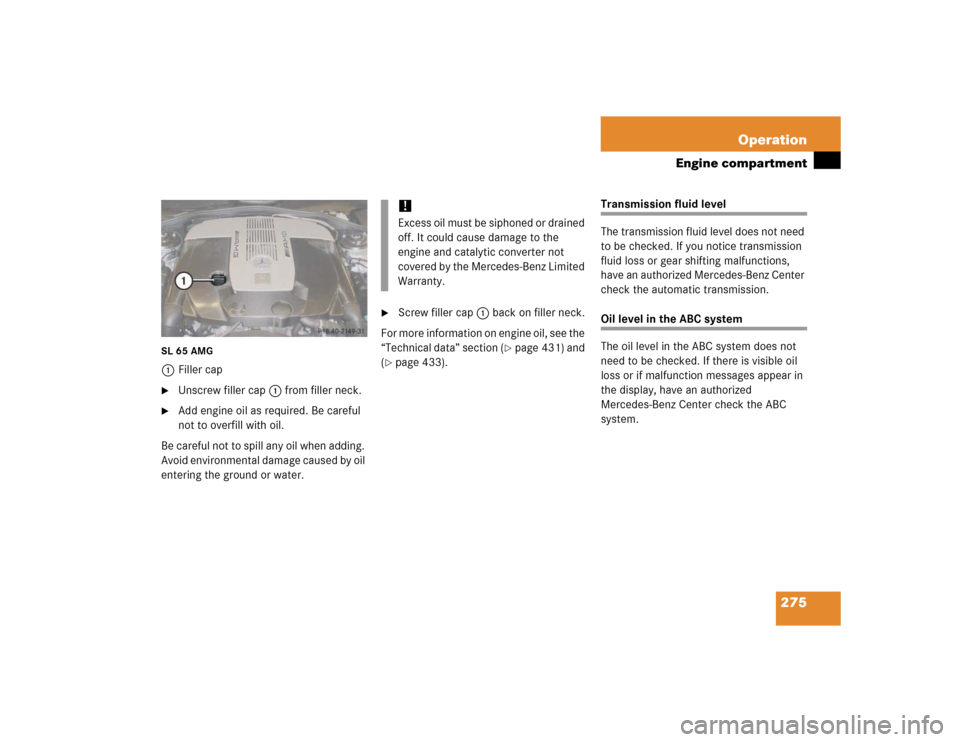
275 Operation
Engine compartment
SL 65 AMG1Filler cap�
Unscrew filler cap1 from filler neck.
�
Add engine oil as required. Be careful
not to overfill with oil.
Be careful not to spill any oil when adding.
Avoid environmental damage caused by oil
entering the ground or water.
�
Screw filler cap1 back on filler neck.
For more information on engine oil, see the
“Technical data” section (
�page 431) and
(
�page 433).
Transmission fluid level
The transmission fluid level does not need
to be checked. If you notice transmission
fluid loss or gear shifting malfunctions,
have an authorized Mercedes-Benz Center
check the automatic transmission. Oil level in the ABC system
The oil level in the ABC system does not
need to be checked. If there is visible oil
loss or if malfunction messages appear in
the display, have an authorized
Mercedes-Benz Center check the ABC
system.
!Excess oil must be siphoned or drained
off. It could cause damage to the
engine and catalytic converter not
covered by the Mercedes-Benz Limited
Warranty.
Page 278 of 474
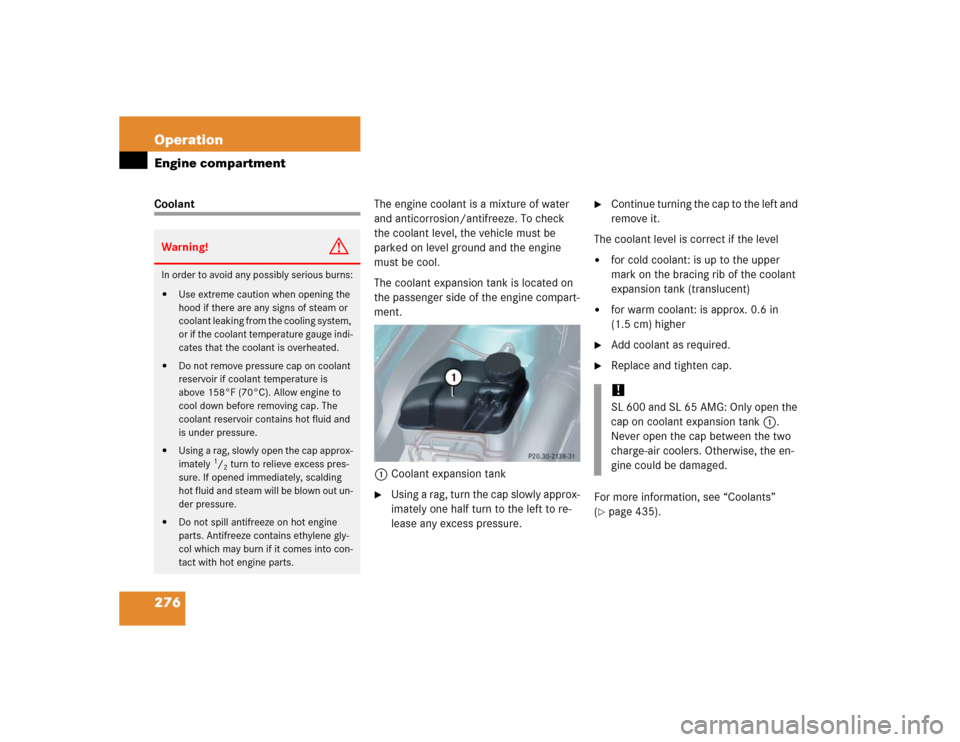
276 OperationEngine compartmentCoolantThe engine coolant is a mixture of water
and anticorrosion/antifreeze. To check
the coolant level, the vehicle must be
parked on level ground and the engine
must be cool.
The coolant expansion tank is located on
the passenger side of the engine compart-
ment.
1Coolant expansion tank
�
Using a rag, turn the cap slowly approx-
imately one half turn to the left to re-
lease any excess pressure.
�
Continue turning the cap to the left and
remove it.
The coolant level is correct if the level
�
for cold coolant: is up to the upper
mark on the bracing rib of the coolant
expansion tank (translucent)
�
for warm coolant: is approx. 0.6 in
(1.5 cm) higher
�
Add coolant as required.
�
Replace and tighten cap.
For more information, see “Coolants”
(
�page 435).
Warning!
G
In order to avoid any possibly serious burns:�
Use extreme caution when opening the
hood if there are any signs of steam or
coolant leaking from the cooling system,
or if the coolant temperature gauge indi-
cates that the coolant is overheated.
�
Do not remove pressure cap on coolant
reservoir if coolant temperature is
above 158°F (70°C). Allow engine to
cool down before removing cap. The
coolant reservoir contains hot fluid and
is under pressure.
�
Using a rag, slowly open the cap approx-
imately
1/2 turn to relieve excess pres-
sure. If opened immediately, scalding
hot fluid and steam will be blown out un-
der pressure.
�
Do not spill antifreeze on hot engine
parts. Antifreeze contains ethylene gly-
col which may burn if it comes into con-
tact with hot engine parts.
!SL 600 and SL 65 AMG: Only open the
cap on coolant expansion tank1.
Never open the cap between the two
charge-air coolers. Otherwise, the en-
gine could be damaged.
Page 280 of 474
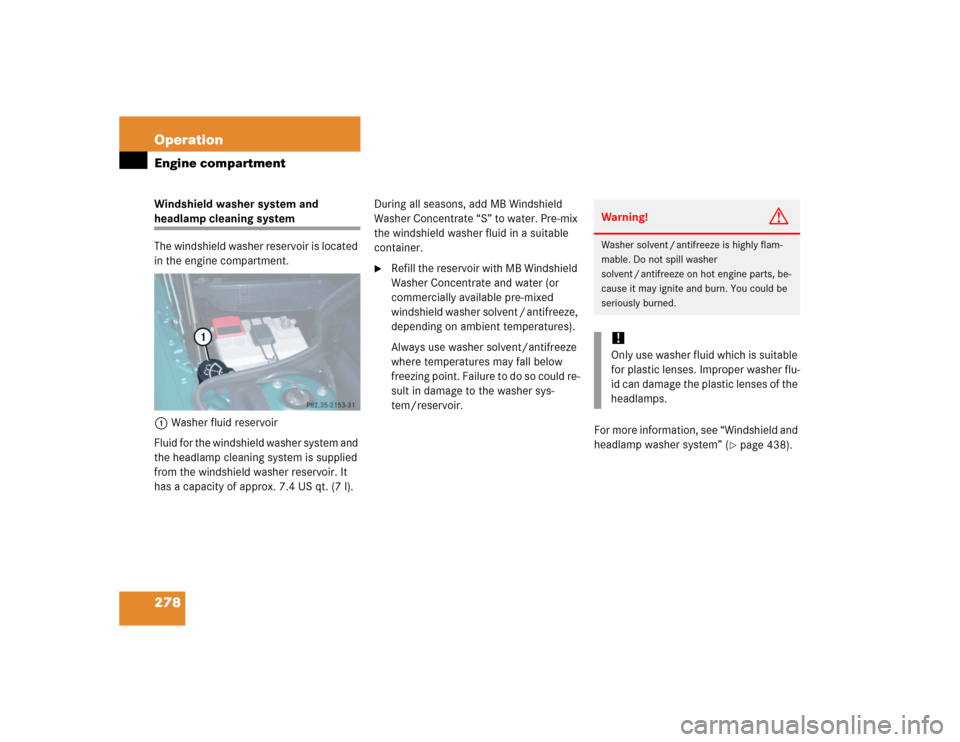
278 OperationEngine compartmentWindshield washer system and headlamp cleaning system
The windshield washer reservoir is located
in the engine compartment.
1Washer fluid reservoir
Fluid for the windshield washer system and
the headlamp cleaning system is supplied
from the windshield washer reservoir. It
has a capacity of approx. 7.4 US qt. (7 l).During all seasons, add MB Windshield
Washer Concentrate “S” to water. Pre-mix
the windshield washer fluid in a suitable
container.
�
Refill the reservoir with MB Windshield
Washer Concentrate and water (or
commercially available pre-mixed
windshield washer solvent / antifreeze,
depending on ambient temperatures).
Always use washer solvent/antifreeze
where temperatures may fall below
freezing point. Failure to do so could re-
sult in damage to the washer sys-
tem/reservoir.
For more information, see “Windshield and
headlamp washer system” (
�page 438).
Warning!
G
Washer solvent / antifreeze is highly flam-
mable. Do not spill washer
solvent / antifreeze on hot engine parts, be-
cause it may ignite and burn. You could be
seriously burned.!Only use washer fluid which is suitable
for plastic lenses. Improper washer flu-
id can damage the plastic lenses of the
headlamps.
Page 317 of 474

315 Operation
Vehicle care
�Vehicle care
Cleaning and care of the vehicle
While in operation, even while parked, your
vehicle is subjected to varying external in-
fluences which, if gone unchecked, can at-
tack the paintwork as well as the
underbody and cause lasting damage.Such damage is caused not only by ex-
treme and varying climatic conditions, but
also by:
�
Air pollution
�
Road salt
�
Tar
�
Gravel and stone chipping
To avoid paint damage, you should imme-
diately remove:
�
Grease and oil
�
Fuel
�
Coolant
�
Brake fluid
�
Bird droppings
�
Insects
�
Tree resins, etc.
Frequent washing reduces and / or elimi-
nates the aggressiveness and potency of
the above adverse influences.More frequent washings are necessary to
deal with unfavorable conditions:
�
near the ocean
�
in industrial areas (smoke, exhaust
emissions)
�
during winter operation
You should check your vehicle from time to
time for stone chipping or other damage.
Any damage should be repaired as soon as
possible to prevent corrosion.
In doing so, do not neglect the underbody
of the vehicle. A prerequisite for a thor-
ough check is a washing of the underbody
followed by a thorough inspection. Dam-
aged areas need to be re-undercoated.
Your vehicle has been treated at the facto-
ry with a wax-base rustproofing in the body
cavities which will last for the lifetime of
the vehicle. Post-production treatment is
neither necessary nor recommended by
Mercedes-Benz because of the possibility
of incompatibility between materials used
in the production process and others ap-
plied later.
Warning!
G
Many cleaning products can be hazardous.
Some are poisonous, others are flammable.
Always follow the instructions on the partic-
ular container. Always open your vehicle’s
doors or windows when cleaning the inside.
Never use fluids or solvents that are not de-
signed for cleaning your vehicle.
Page 328 of 474
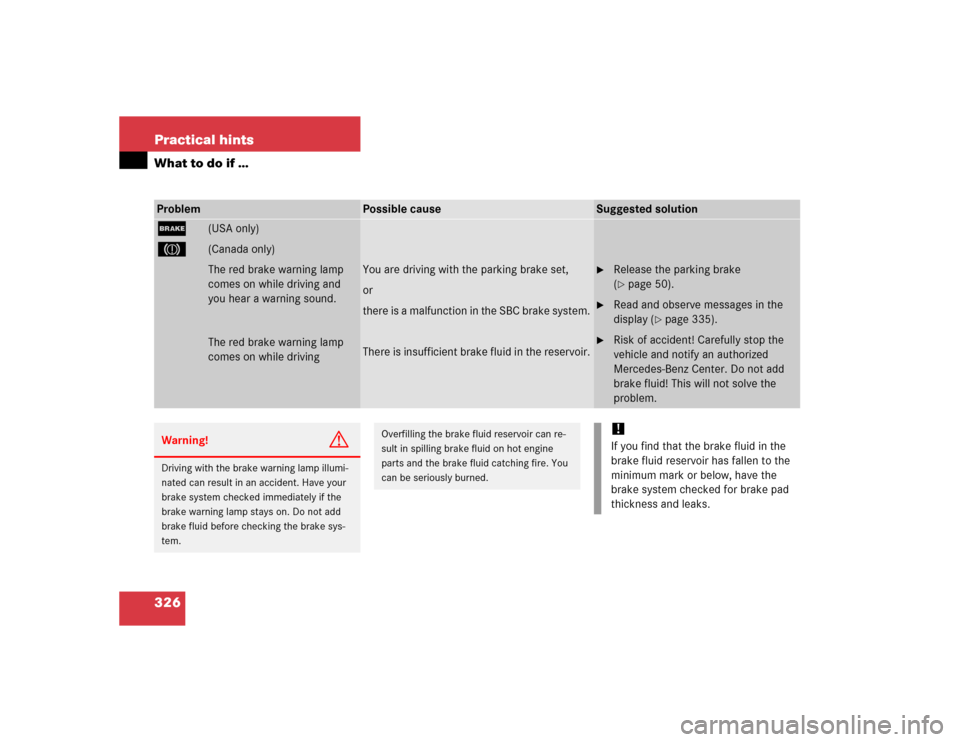
326 Practical hintsWhat to do if …Problem
Possible cause
Suggested solution
;
(USA only)
3
(Canada only)
The red brake warning lamp
comes on while driving and
you hear a warning sound.
The red brake warning lamp
comes on while driving
You are driving with the parking brake set,
or
there is a malfunction in the SBC brake system.
There is insufficient brake fluid in the reservoir.
�
Release the parking brake
(�page 50).
�
Read and observe messages in the
display (
�page 335).
�
Risk of accident! Carefully stop the
vehicle and notify an authorized
Mercedes-Benz Center. Do not add
brake fluid! This will not solve the
problem.
Warning!
G
Driving with the brake warning lamp illumi-
nated can result in an accident. Have your
brake system checked immediately if the
brake warning lamp stays on. Do not add
brake fluid before checking the brake sys-
tem.
Overfilling the brake fluid reservoir can re-
sult in spilling brake fluid on hot engine
parts and the brake fluid catching fire. You
can be seriously burned.
!If you find that the brake fluid in the
brake fluid reservoir has fallen to the
minimum mark or below, have the
brake system checked for brake pad
thickness and leaks.
Page 331 of 474
329 Practical hints
What to do if …
Warning!
G
Driving when your engine is badly overheat-
ed can cause some fluids which may have
leaked into the engine compartment to
catch fire. You could be seriously burned.
Steam from an overheated engine can cause
serious burns and can occur just by opening
the engine hood. Stay away from the engine
if you see or hear steam coming from it.
Turn off the engine, get out of the vehicle
and do not stand near the vehicle until the
engine has cooled down.
Page 351 of 474
349 Practical hints
What to do if …
Left display
Right display
Possible cause
Possible solution
USA only:;Canada only:3
Brake fluid
below min. level
Visit
workshop
There is insufficient brake fluid in
the reservoir.
�
Risk of accident! Stop the vehicle as soon as
it is safe to do so and notify an authorized
Mercedes-Benz Center.
Do not add brake fluid! This will not solve the
problem.
!If you find that the brake fluid in the
brake fluid reservoir has fallen to the
minimum mark or below, have the
brake system checked for brake pad
thickness and leaks.
Warning
G
Driving with this message displayed can re-
sult in an accident. Have your brake system
checked immediately. Do not add brake flu-
id before checking the brake system. Over-
filling the brake fluid reservoir can result in
spilling brake fluid on hot engine parts and
the brake fluid catching fire. You can be se-
riously burned.
Page 354 of 474
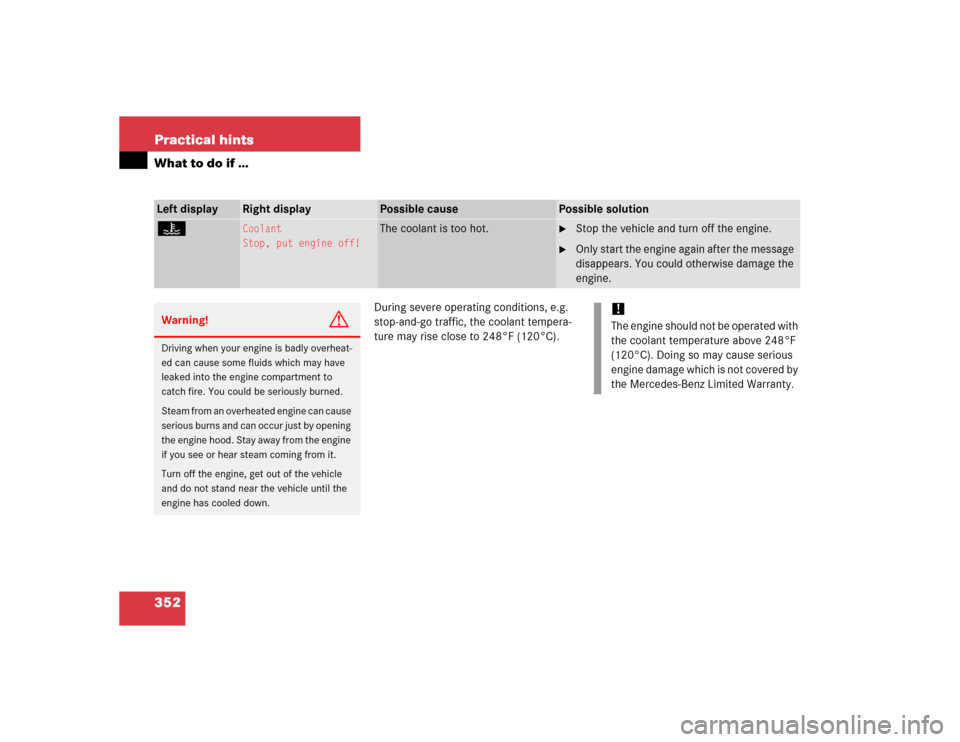
352 Practical hintsWhat to do if …
During severe operating conditions, e.g.
stop-and-go traffic, the coolant tempera-
ture may rise close to 248°F (120°C).
Left display
Right display
Possible cause
Possible solution
•
Coolant
Stop, put engine off!
The coolant is too hot.
�
Stop the vehicle and turn off the engine.
�
Only start the engine again after the message
disappears. You could otherwise damage the
engine.
Warning!
G
Driving when your engine is badly overheat-
ed can cause some fluids which may have
leaked into the engine compartment to
catch fire. You could be seriously burned.
Steam from an overheated engine can cause
serious burns and can occur just by opening
the engine hood. Stay away from the engine
if you see or hear steam coming from it.
Turn off the engine, get out of the vehicle
and do not stand near the vehicle until the
engine has cooled down.
!The engine should not be operated with
the coolant temperature above 248°F
(120°C). Doing so may cause serious
engine damage which is not covered by
the Mercedes-Benz Limited Warranty.